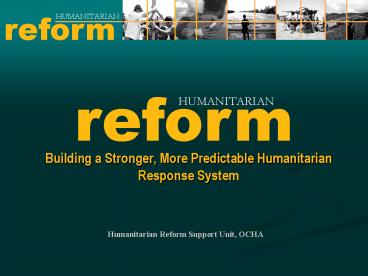Building a Stronger, More Predictable Humanitarian Response System PowerPoint PPT Presentation
1 / 16
Title: Building a Stronger, More Predictable Humanitarian Response System
1
reform
HUMANITARIAN
reform
HUMANITARIAN
Building a Stronger, More Predictable
Humanitarian Response System
Humanitarian Reform Support Unit, OCHA
2
- Whose reform?
- Inter-Agency Standing Committee (IASC)
- Composed of NGO consortia, Red Cross and Red
Crescent Movement, IOM, World bank and UN
agencies
3
The Three Pillars of the Reform
The Cluster Approach
Humanitarian Coordinators
Humanitarian Financing
Partnerships
4
Strengthening Leadershipthe Humanitarian
Coordinator System
- HC/RC strengthening project
- HC Pool of qualified leaders
- Appropriate training and support system for
existing and future HCs and RCs - Agreed system for designation of HCs
5
Predictable Humanitarian Financing
- CERF
- Emergency Response Funds
- Common Humanitarian Funds (pooled funds)
6
Ensuring Capacity Predictability The Cluster
Approach
7
AIM OF THE CLUSTER APPROACH
- High standards of predictability, accountability
and partnership in all sectors or areas of
activity - Responsibility to include all humanitarian
partners - More strategic and inclusive responses
- Better prioritization of available resources
- Strengthening humanitarian response
8
reform
HUMANITARIAN
- Cluster/Sector Working Group
- Agriculture
- Camp Coordination Camp Mgmt
- Early Recovery
- Education
- Emergency Shelter
- Emergency Telecomms
- Health
- Logistics
- Nutrition
- Protection
- Water, Sanitation Hygiene
Global Cluster Leads FAO UNHCR IOM
UNDP UNICEF Save the Children UNHCR IFRC
(Convenor) OCHA (UNICEF WFP) WHO WFP UNICEF
UNHCR UNICEF
9
What is a Cluster
- A group of organizations providing services
within the same theme, e.g. health or
protection with ONE lead - The cluster ensures overall inclusion of all
partners, who can then divide into working or
thematic groups (e.g. child protection or gender) - Ensures cross-fertilization between organizations
working within same theme despite different
focus (e.g. child protection and SGBV) - Ensures a collective agreement and planning for
the overall direction of the response within a
given theme - Ensures a needs rather than capacity driven
response
10
What is a Cluster Lead
- A cluster lead is an agency/organization that
commits to take on a leadership role within the
international humanitarian community in a
particular sector/area of activity, to ensure
adequate response and high standards of
predictability, accountability partnership. - A cluster lead transcends the agency
mandate/agenda and coordinates rather than
dictates
11
reform
HUMANITARIAN
Responsibilities of field-based cluster/sector
leads (Terms of Reference)
- Inclusion of key humanitarian partners
- Appropriate coordination mechanisms
- Coordination with national/local authorities,
local civil society etc. - Participatory and community-based approaches
- Attention to priority cross-cutting issues (age,
environment, gender, HIV/AIDS etc) - Inclusion of early recovery strategy in sector
plans - Ensure capacity building
- Needs assessment and analysis
12
Predictability, Accountability and Partnership
in all response sectors
- Better support to national-led response efforts
- Needs rather than capacity driven response
- Common standards and tools
- Predictable stockpiles and trained expertise
- Unified interface for Governments, donors other
actors - First port of call and provider of last
resort - Mainstreaming Gender, HIV/AIDS, Environment
13
reform
HUMANITARIAN
Government/National Authorities
- The Government has primary role in organizing
humanitarian assistance in a disaster (GA
Resolution 46/182). - Reform promotes closer cooperation and linkages
between national and international partners. - All humanitarian action must be inclusive
- Training and capacity building.
14
reform
HUMANITARIAN
Responsibilities of global cluster leads
- Normative
- Standard setting and consolidation of best
practice - Build response capacity
- Training and system development at local,
regional and international levels - Surge capacity and standby rosters
- Material stockpiles
- Operational Support
- Emergency preparedness
- Advocacy and resource mobilization
- To date, donors have provided USD 60 million to
build global capacity
15
reform
HUMANITARIAN
What is the same from previous ways of working?
- Government still responsible for leading the
response (GA Res 46/182) - When international assistance is required, UN
RC/HC still coordinates international response in
support of government response
What is different from previous ways of working?
- For the first time, clear, agreed focal points
for every area of humanitarian work - Governments now have clearer, more predictable
sectoral counterparts - Each area led by a designated organisation,
with a terms of reference - Terms of Reference sets the standard for a
coordinated response and accountability - NGO/Red Cross partners fully included in
decision-making and planning - Access to global resources stockpiles,
technical expertise, tools, standards - Provider of last resort leads have agreed to
fill gaps
16
- www.humanitarianreform.org

